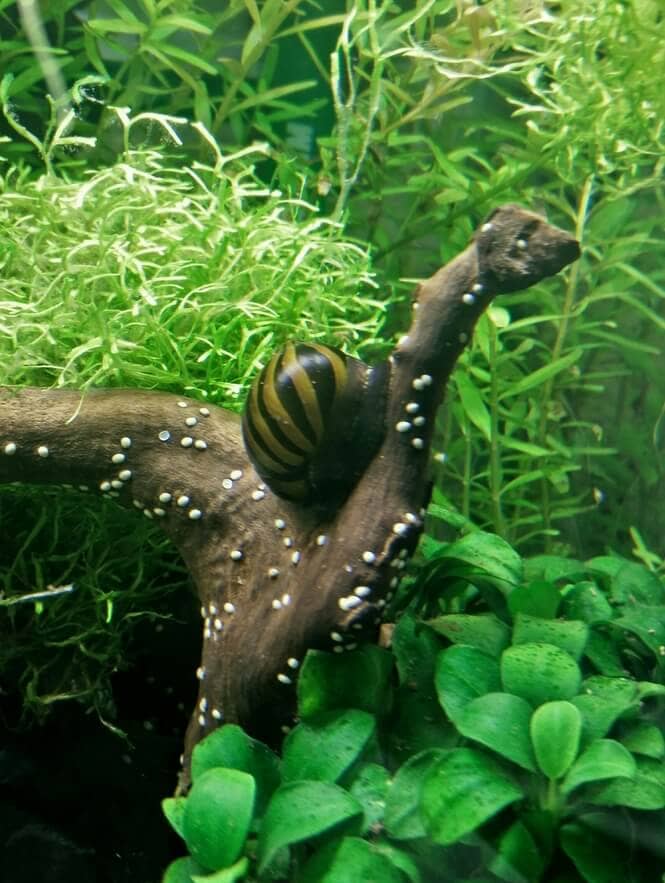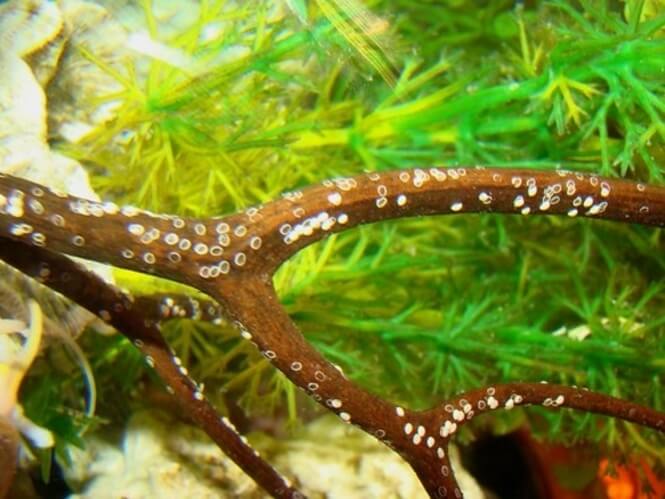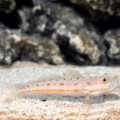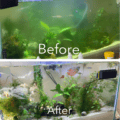Taking care of Nerite snails might be a piece of cake when it comes to their well-being, but do you know what to do with all the tiny white dots that suddenly cover the whole fish tank?

The Nerite snail eggs will keep multiplying and spoiling the inner aesthetics of the aquarium, so you’ll need to find an efficient way for their removal.
Nerite snails are quite adaptive, as they can live and lay eggs in both saline and fresh water. However, the eggs will rarely hatch in freshwater because that’s not the natural reproductive cycle of this type of snail. Nerite larvae prefer brackish water to develop beyond the egg phase and hatch.
Occasionally though, the eggs may hatch in freshwater, but the larvae won’t survive.
A female Nerite snail will keep laying eggs in a freshwater aquarium and they will, in most cases, remain unhatched. From my experience, however, there are several effective methods to deal with this kind of situation.
What to do about unhatched Nerite Snail eggs?
The eggs of a Nerite snail appear as small white ovals and resemble sesame seeds in looks. Technically speaking, these white bumps are not the actual eggs of the snail, but rather tiny capsules that usually hold between 30 and 100 of the actual eggs.

Here’s what the eggs of a Nerite snail look like:
By adequatepotato
Unlike Mystery snail eggs, the egg capsules of Nerite snails will be scattered all over your tank, and especially on driftwood.
Unfortunately, there’s no known creature that would eat the eggs of a Nerite snail. That being said, to get rid of the unhatched nerite snail eggs you can try the following:
1. Interchange the female snails with male ones.

By Ross Engbritson
The majority of freshwater snails are hermaphrodite, which means that they will reproduce asexually.
This is the reason most freshwater aquariums get infested with hundreds of snails when an uninvited hitchhiker ends up in the fish tank.
However, asexual reproduction does not apply to Nerite snails.
These types of snails have distinctive males and females, and breeding includes both genders. The female Nerite lays eggs, which need to be fertilized by a male thereafter.
You can, therefore, remove the females and only leave males in the fish tank.

When it comes to telling the differences between male and female Nerite snails, you’ll need to closely inspect the base of their right eye antenna. The males will have a skin fold at the base of their right eye. The females will lack the fold. Here’s an illustration:
Since spotting the differences may take a long time, I don’t consider it the best method to tell apart Nerite snail genders.
Not all of us have a whole day to stand in front of a fish tank, examining snails with a magnifier.
What worked for me, and I think is the easier way to determine a Nerite snail’s sex, is placing a single one in a 5-gallon bucket and observing if it lays eggs.
It requires some time, but I’ve found it to be a sure way to tell apart the males from the females.
I use the bucket as a “quarantine tank” for new Nerite snails.
If it turns out that a newcomer is a female, I return it and get another one.
Note that for this way of selection to work the Nerite snail must be sexually mature or at least 1 year old.
2. Scrub the eggs with a razor blade.

By Jay_S
You can mechanically scrub the eggs of a Nerite snail by using some sort of tool. To mechanically remove Nerite snail eggs, follow these steps:
- Find a NEW stainless steel razor blade.
- Carefully scrape the eggs from surfaces with the razor blade.
- Collect the fallen eggs with a stainless steel spoon and remove them from the tank.
Make sure you are using a new, unused razor blade.
Also, apply moderate pressure when scraping the eggs, because based on my experience, removal can be somewhat difficult.
I find using a spoon the best way to collect fallen eggs.
It’s important that both tools are made of stainless steel as that’s an aquarium-safe material. Another method I’ve seen success with is by using a sharp algae scraper like this one or something similar.
You can also use a toothbrush, a toothpick, or any sharp tool that you think may work best for you.
Just be careful with the eggs on driftwood, because each removed egg will leave an oval trace.
In my experience, it’s nearly impossible to remove a Nerite’s eggs from driftwood without taking off some of the outer layer of wood.
3. Remove the Nerite snails from the fish tank altogether.

By shannon767
At one point, you may simply lose your motivation to keep trying different tricks for snail egg removal.
In such cases, you can just get rid of all the Nerite snails altogether. Here are a couple of ideas on how to do that:
- Get some fish that are known for eating aquatic snails.
These can include clown loaches, Betta fish, or Pictus catfish.
However, I would not recommend getting a fish just for the sake of removing snails.
Do your research on snail-eating fish and make sure to supplement their diet as necessary.
- Use chemicals, such as copper sulfate.
Frankly, I do not recommend this option, because copper is highly toxic to not only the Nerite snails but all the invertebrates, including shrimp.
Some of your more fragile aquarium plants may also get affected.
If you still want to go ahead with this method, then you need to be very precise with following the instructions on how to use the copper sulfate.
A fish-safe dose of copper sulfate in a freshwater aquarium is in the range of between 0.15 and 0.2 mg/L.
Take into consideration the temperature of the aquarium water and its pH.
As water temperature increases, so does the toxicity, but the right dosage for certain water temperatures will be mentioned on the label of the medicine.
Also, if your water is softer, using copper may turn into a hazardous game for your pet fish.
- Put the Nerite snails into a separate freshwater aquarium.
Or simply return them to the pet shop.
The female Nerite snails will keep laying eggs everywhere, as this is what they usually do.
How to hatch the eggs of a Nerite snail?
There are over 200 Nerite snail types and not all of them are fully researched when it comes to hatching.
Luckily, the majority of Nerite snails sold in pet shops are well-known to science.
If you are interested in seeing your Nerite eggs developing into fully-grown snails, there are some steps to be followed.
That being said, here’s how to hatch the eggs of Nerite snails:
- Set up a separate aquarium with brackish water.
- Put a couple of snails in the new tank. Putting between 5 and 7 will likely be enough to make sure there are males and females.
- Return the mature snail parents back to your freshwater aquarium after the larvae have hatched.
- Feed the babies around 2 to 3 times per day if there are no algae in the aquarium. You can use spirulina powder or phytoplankton to feed the Nerite larvae.
- After 30 days place the grown-up larvae into your freshwater fish tank.
Make sure you use marine salt (do not mistake it for aquarium salt) when preparing the brackish water.
Suggested Read: Ideas for Brackish Aquarium Fish
Anyway, use a hydrometer to test the salinity and stop adding salt when the reading (SG or Specific Gravity) shows anything between 1.002 – 1.005.
Depending on the salinity the eggs will hatch after 20 to 25 days. The temperature should be kept between 79 and 85 °F (26.1 to 29.4 °C).
Alternatively, for step 2, instead of adding the snails to the brackish water, you can move the egg-covered decorations, as they are likely fertilized by the male Nerite snails in the main tank.
This is a preventive measure because once the baby snails are hatched, they will be really tiny and may get sucked by the water filter.
Wait about 3 to 4 weeks for the larvae to become bigger and place them into your original freshwater aquarium.
Avoid having aggressive and carnivorous fish in the freshwater tank, as the small baby snails can easily become prey.
How to Reduce the Number of Eggs Your Nerite Snails Lay?
Even though there are several ways you can deal with the constant laying of eggs by your nerite snails, doing so can certainly be a nuisance.
Fortunately, there are other ways in which you can keep the number of the eggs fairly low.
Here’s how to decrease the number of nerite snail eggs in your tank:
- Don’t overfeed.
Overfeeding is one of the main reasons that lead to an increase in the number of nerite snail eggs.
Therefore, rationing their food so they don’t eat more than they need to will decrease the number of eggs they lay.
Pay attention to how much food is left uneaten when you offer and adjust the portions accordingly.
- Increase water temperature.
Increasing water temperature can reduce the number of eggs since nerite snails typically spawn at colder temperatures.
You should be able to see a decrease in the number of eggs when you increase the temperature by a few degrees.
If you resort to this method, be sure that the other desinens in the fish tank can handle the temperature change.
Lowering the temperature should be gradual or you risk stressing everyone in the aquarium system, including beneficial bacteria.
- Remember to keep the aquarium clean.
Nerite snails kind of thrive in what we call a dirty tank.
To them this dirty environment is actually a feast and an ideal breeding ground.
Keeping the tank clean will negate this effect and your Nerite snails won’t be as eager to lay too many eggs.
My Conclusion
The constant influx of eggs the Nerite snails produce can definitely be bothersome.
In my experience, the most efficient way to benefit from having this snail species is to take time to identify and separate the males from the females.
This is probably the way I’d go about it if I were facing the issue right now.
It may be time-consuming but once you get rid of the female the issue with the eggs will be resolved.
What did you end up doing? What tools did you use to scrape the eggs?
Tell me your story in the comment section below.











I found this post really helpful! I’ve been wondering what to do with the unhatched nerite snail eggs in my tank. Your suggestions about keeping the environment stable and waiting for them to hatch were especially useful. I didn’t realize how important it is to monitor water conditions. Thanks for sharing your insights!